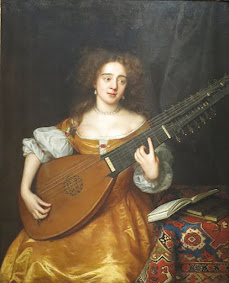Theorbo player staged the world’s first public opera
.jpg) |
| Manelli worked in Tivoli, Rome and Padua before settling in Venice |
Manelli (sometimes spelt Mannelli) was also a skilled player of the theorbo, which is a plucked string instrument belonging to the lute family that has a very long neck.
From the age of ten, Manelli used to sing in Tivoli's Duomo, the Basilica Cattedrale di San Lorenzo Martire, and he was taught music by the various maestri di cappella working there at that time.
Manelli moved to Rome with the intention of studying for a career in the church, but after meeting and marrying a singer, Maddalena, he decided to dedicate himself exclusively to music.
In 1627, Manelli went back to Tivoli where he himself became a maestro di cappella at the Duomo, a post he held for two years. Then he returned to Rome to take up the post of maestro di cappella at the church of Santa Maria della Consolazione.
After going to Padua, where his wife sang in the opera Ermiona, Manelli and his family settled in Venice in order to be close to his patron.
In 1637, Manelli and another composer and theorbo player, Benedetto Ferrari, put together a company of singers to present an opera in a public theatre, which was the first time this had happened. The singers performed Andromeda, an opera, with music written by Manelli and a libretto written by Ferrari, at Teatro San Cassiano during that year’s Carnevale. Manelli himself sang two of the bass parts.
 |
| A 17th century painting of an English woman playing the theorbo |
In 1639, Manelli composed La Delia, with a libretto by Giulio Strozzi, which premiered at Teatro Santi Giovanni e Paolo in Venice. This was followed by his operas, Adone in 1640 and L’Alcate in 1642, which were both performed at the same theatre.
Between 1639 and 1642, Manelli and Ferrari directed a company of Venetian singers in Bologna, which included Manelli’s wife, Maddalena, and their son, Constantino. In addition to Manelli’s own compositions, the singers performed Il ritorno di Ulisse in patria by Claudio Monteverdi.
In 1645, Manelli and his family went into the service of Ranuccio II Farnese, the Duke of Parma. Manelli composed five operas for the court, which were performed in the ducal theatre of Parma and Piacenza.
Manelli died in Parma in 1667 and his wife, Maddalena, died there in 1680.
_wooden_model.jpg) |
| A wooden model of how the theatre might have looked |
Teatro San Cassiano, which was located in the San Cassiano parish of Venice’s Santa Croce sestiere, was the world’s first ever public opera house thanks to Francesco Manelli and Benedetto Ferrari. This sparked a global opera boom and established Venice as its capital. There is now a project to reconstruct the Teatro San Cassiano of 1637 as faithfully as modern scholarship and traditional craftsmanship will allow to deliver a fully functioning dedicated Baroque opera house and a centre for research into Baroque opera.
 |
| Tivoli's attractions include the gardens and fabulous fountains of the 16th century Villa d'Este |
Tivoli, where Francesco Manelli was born, is a town in Lazio, situated about 30km (19 miles) northeast of Rome. The city offers a wide view over the Roman Campagna, a low-lying area of countryside surrounding Rome. Tivoli is famous for being the site of Hadrian’s villa, a large villa complex built around AD 120 by the Roman Emperor Hadrian, and the Villa d’Este, a 16th century villa, famous for its terraced hillside Renaissance garden and its abundance of fountains. Both villas are UNESCO World Heritage sites.
Also on this day:
1506: The death of painter Andrea Mantegna
1583: The birth of composer Girolamo Frescobaldi
1808: The death of writer Saverio Bettinelli
1973: The birth of footballer Fabio Cannavaro